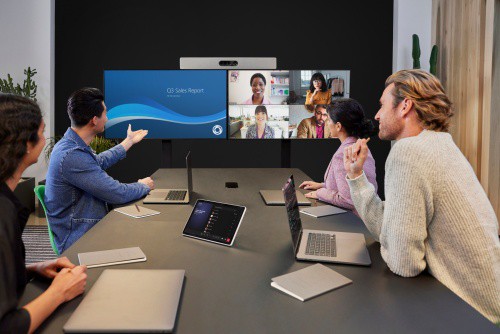Cisco has unveiled major updates to its Webex suite, which includes new collaboration and security features for hybrid work, a partnership with Microsoft, and a brand-new whiteboarding app.
The announcements, made last Wednesday at the company’s annual WebexOne Conference, seek to advance the next-generation of hybrid work. They are also meant to address the continuing disconnect felt by remote staff for not sharing the same physical space with their in-office colleagues.

“Not all work styles are created equal,” said Jeetu Patel, EVP and general manager at Cisco security and collaboration, during a media briefing. “We made sure to support many types of interaction."
He pointed out that the problem cannot be solve in isolation. “This requires a holistic solution that we can deliver with an integrated platform across collaboration software, devices, networking and security.”
Reimagined workspaces
While hybrid work has become the new normal over the last three years, Patel said only 6.4% of meetings rooms are video-enabled citing a recent Frost & Sullivan report. Another survey conducted this year conducted among Cisco customers revealed that 85% use more than one meeting platform.
“It’s critical for those video devices to provide seamless interoperability with the platforms colleagues and customers use,” Patel said.
Towards this end, a substantial chunk of the new capabilities of the Webex platform is around the “reimagined workplace”. Cisco has formed a number of partnerships to improve video interoperability on the platform.

For one, Cisco has partnered with Apple to enable iPhone and iPad users can now share content from the rear-facing or front-facing camera via the Webex Meetings app and annotate over what they’re seeing with Mobile Camera Share.
“For the first time customers benefit from effective collaboration by leveraging the high-quality video capture capabilities of Apple devices. For example, an architect or frontline worker can share job site progress with clients in real-time instead of sending static images or screenshots,” Patel said.
The company’s latest partnership with Microsoft enables Microsoft Teams Rooms to run on Cisco’s collaboration devices.
“The future is multi-platform. We now have capabilities on the hardware level to make sure, each platform gets better with our native support for Microsoft Teams,” said Patel.
Furthermore, Webex Calling includes new integration with Microsoft Teams, enabling users to easily make enterprise-grade Webex Calls seamlessly in the Teams interface for a more flexible workflow. Meanwhile, Group Call Management is now available for Webex Calling. This capability makes it easy for businesses to activate informal call centre services to elevate their customer calling experience, measure performance, improve staff training, and deliver results without needing a separate or specialised contact centre application.
Another announcement in the new Cisco Room Kit EQ, an AI-based computing appliance, that allows true-to-life meeting experiences. It brings seamless integration to video-enable and transform large spaces for inclusive hybrid work.
Brand new whiteboard app
Meanwhile, Cisco announced several innovations on Webex – most notably a new whiteboard app that allows both in-office and remote workers to sketch on a whiteboard spontaneously.
“Anyone can start or join a whiteboard and work together from a browser, the Webex App, or a Cisco device. Whiteboards can be combined with Slido polls, saved and shared in a Webex space for asynchronous ideation,” said Patel.
The company has also made its asynchronous video tool Vidcast, which was launched last year, generally available. To date, Vidcast has saved 47 million meeting minutes. More than 40 new innovations make the experience even more powerful, including a new AI-powered editing capability that drastically reduces the time it takes to create polished content, and Slido integration to incorporate polling and audience engagement into shared video content.
For connected events hosted over Webex Events and Webinars, users will now have access to a new lobby experience for virtual events that will support a variety of customisations, such as agendas, speaker bios, sponsors, and more.
New content widgets make it easy to embed any of those elements into external event websites. With new production tools in Webex Webinars, hosts can easily add custom branding and personalization to every event with the new Stage Manager. Integration into Network Device Interface (NDI) gives event production teams a new tool for professional broadcasts.
Built-in security
The final set of announcements is around security features – most specifically audio watermarking that uniquely tags audio streams to every participant in a confidential meeting with a market that cannot be heard by the human ear.
“This allows organisations to better protect intellectual property in today’s hybrid world with more highly dispersed and remote teams,” said Patel. “For example, if an employee were recording a meeting where confidential information is discussed, the company could trace that recording back to the individual regardless of how the audio was shared.”
Other updates are added to put the power int the hands of IT, ensuring the supporting IT operations are deployed, optimised, and monitored effectively and securely:
- Webex Control Hub is now integrated with Cisco Spaces. This integration offers employees critical information, such as real-time occupancy and air quality updates, which improves their experience when they come into the office. Facilities and real estate teams benefit from real-time data to simplify the complexity of reconfiguring and redesigning workspaces while supporting sustainability goals.
- Control Hub as a Coach offers Webex customers an in-product digital coach that takes the complexity out of improving hybrid work experiences. Control Hub guides IT admins to achieve best practice set up, adoption quality, and create greater efficiency for managing and supporting workers.





